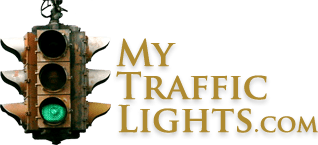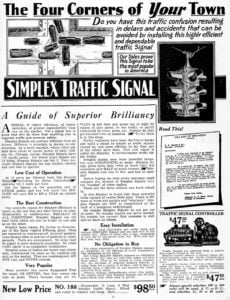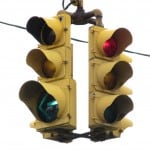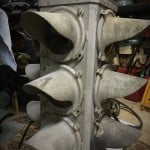Oh, my Darley. Oh, my Darley!
My latest traffic light acquisition is a four-way three-bulb W.S. Darley Simplex C-811 from Colorado. I thought I was almost done with collecting 4-way signals (Who am I kidding?), and my wife wishes I was done with them too, but the uniqueness and history of the Darley Simplex signals intrigued me and I couldn't resist.
Since the 1930s, a committee called the American Society for Municipal Improvements recommended that red be on top and green be on the bottom. And since the 1950s, the MUTCD (Manual on Uniform Traffic Control Devices) has stated that all vertically mounted traffic signals must have indications of red on top, yellow (or amber) in the middle, and green on the bottom. This is a standard to make sure there's no confusion when approaching intersections, especially for the color blind. The only exception is one intersection in Syracuse, New York. Up until this time, it was more or less the wild west of traffic light design and signal manufacturers came up with a few different designs. W.S. Darley manufactured signals from about the 1930s into about the 1950s, and in the earlier years, without those regulations on how traffic lights had to be built, a subtle but iconic traffic light was inadvertently designed.
Fixed-4-way traffic signals were built with a bulb for each indication and direction of red, yellow, and green, which meant that it had 12 sockets, wiring to 12 sockets, and 12 light bulbs. Darley came up with a design that was much simpler and much less expensive to build. Each section – top, middle, and bottom – had one bulb to illuminate all four directions. But if the top section was lit to give main street a red light, that same top section also had to have green lit for the cross street. This meant that the green had to be in the top section as well as the red. So for Main Street, you had red on top and green on the bottom but the cross street had green on top and red on the bottom. The reverse was true for the bottom section. Ingenious! Well, not completely, as this was originally done by William Potts' and his 4-way signal, considered the precursor to 4-way traffic lights as we know them today. Many of these even came with its own built-in controller. Talk about plug-n-play!
Although this was a very simple and economic design, it had its flaws. The biggest was if a bulb burned out, you now had four directions that were dark. Remember, that one bulb illuminated all four ways. And since it had a on-board timer, there was no way to synchronize it with other signals in the area. Generally this was a low-cost signal that was designed for small towns that probably only had the one signal, so that was rarely an issue. W.S. Darley also built traffic lights that were proper 4-way signals for those areas that required compliance, which meant that after the standardization, 3-bulb Darley signals went the way of the Dodo bird.
Because it's a fixed-4-way is not to say why these signals are unique among other fixed-4-ways. Despite Darley ceasing production in the 1950s, many fixed 4-way signals were no longer being manufactured after the 1960s because it was much more economic to build and install clusters of single-face signals. These clusters also had an advantage of being able to be angled left or right in off-axis intersections where a fixed 4-way could really only point in 90-degrees in each direction. What makes this signal unique is the 3-bulb design. It came at a time where simplicity reigned before standards. It was a cost-savings option that was offered to municipalities that didn't need complication. They wanted something that did its job and worked well. As a testament to the W. S. Darley, the 60-year-old electro-mechanical controller in mine still works.









